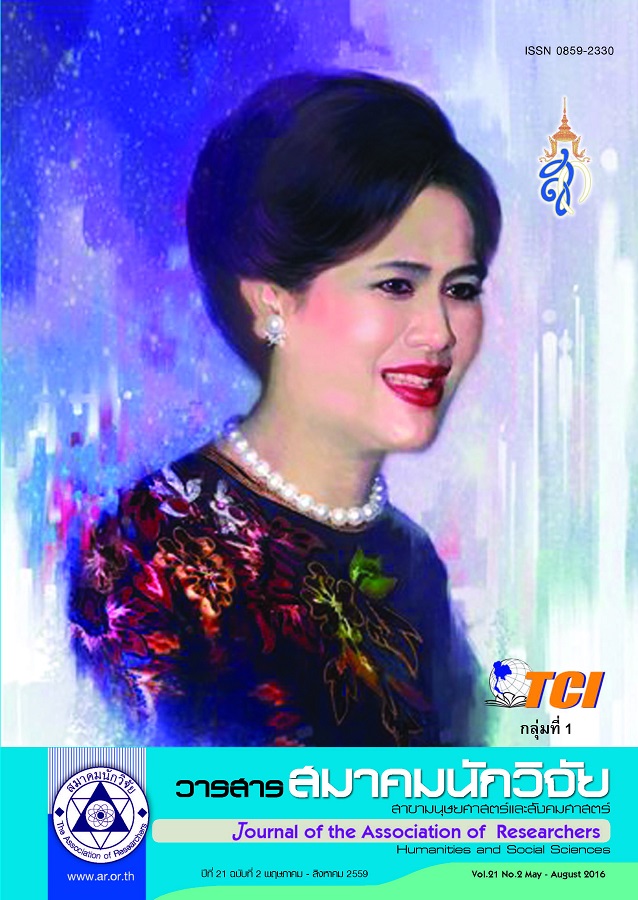อิทธิพลของภาพลักษณ์ร้านค้าคุณค่าความสัมพันธ์พฤติกรรมการบริการและการซื้อซ้ำที่มีต่อความภักดีของลูกค้าในร้านค้าปลีกดั้งเดิม
Main Article Content
บทคัดย่อ
ารวิจัยมีวัตถุประสงค์เพื่อศึกษาภาพลักษณ์ร้านค้า คุณค่าความสัมพันธ์ พฤติกรรมการบริการ การซื้อซ้ำและ ความภักดีของลูกค้าตลอดจนศึกษาอิทธิพลของภาพลักษณ์ร้านค้า คุณค่าความสัมพันธ์ พฤติกรรมการบริการและการซื้อซ้ำ ที่มีต่อความภักดีของลูกค้าในร้านค้าปลีกดั้งเดิม กลุ่มตัวอย่าง คือ ลูกค้าที่เคยใช้บริการร้านค้าปลีกดั้งเดิม จำนวน 359 ราย เป็นวิจัยเชิงปริมาณ เครื่องมือวิจัย คือ แบบสอบถาม โดยใช้สถิติพรรณนาวิเคราะห์ค่าร้อยละและส่วนเบี่ยงเบนมาตรฐาน สถิติอนุมานวิเคราะห์สมการโครงสร้างด้วยเทคนิค SMART-PLS ผลวิจัยพบว่าลูกค้าให้ความสำคัญกับคุณค่าความสัมพันธ์ ความภักดีของลูกค้า พฤติกรรมการบริการและการซื้อซ้ำ ระดับมาก ส่วนภาพลักษณ์ร้านค้าระดับปานกลางการวิเคราะห์สมการโครงสร้างพบว่าภาพลักษณ์ร้านค้ามีอิทธิพลทางตรง ต่อพฤติกรรมการบริการมากที่สุด รองลงมาภาพลักษณ์ร้านค้ามีอิทธิพลทางตรงต่อคุณค่าความสัมพันธ์ การซื้อซ้ำมีอิทธิพล ทางตรงต่อความภักดีของลูกค้าคุณค่าความสัมพันธ์มีอิทธิพลทางตรงต่อการซื้อซ้ำ คุณค่าความสัมพันธ์มีอิทธิพลทางตรงต่อ ความภักดีของลูกค้าพฤติกรรมการบริการมีอิทธิพลทางตรงต่อการซื้อซ้ำ พฤติกรรมการบริการมีอิทธิพลทางตรงต่อความ ภักดีของลูกค้า สุดท้ายภาพลักษณ์ร้านค้ามีอิทธิพลทางตรงต่อการซื้อซ้ำ โดยที่ภาพลักษณ์ร้านค้ามีอิทธิพลทางอ้อมต่อ ความภักดีของลูกค้า
Article Details
บทความที่ปรากฏในวารสารนี้ เป็นความรับผิดชอบของผู้เขียน ซึ่งสมาคมนักวิจัยไม่จำเป็นต้องเห็นด้วยเสมอไป การนำเสนอผลงานวิจัยและบทความในวารสารนี้ไปเผยแพร่สามารถกระทำได้ โดยระบุแหล่งอ้างอิงจาก "วารสารสมาคมนักวิจัย"
References
ธนาภรณ์ แสวงทองและคณะ. (2555). ผลกระทบจากการขยายตัวของร้านค้าปลีกสมัยใหม่ต่อร้านค้าปลีกดั้งเดิมในเขต พื้นที่กรุงเทพมหานครและปริมณฑล. วารสารช่อพะยอม, 23: 66-81.
มนตรี พิริยะกุล และบุญฑวรรณ วิงวอน. (2553). ตัวแบบเส้นทาง PLS ของความรับผิดชอบต่อสังคม การรับรู้คุณภาพ สินค้าและบริการ พฤติกรรมการเป็นลูกค้าที่ดีและการรับรู้ถึงผลการปฏิบัติงาน ของร้านค้าปลีกดั้งเดิม. ลำปาง : คณะวิทยาการจัดการ มหาวิทยาลัยราชภัฏลำปาง.
ศุภรา เจริญภูมิ. (2554). ปัจจัยที่มีอิทธิพลต่อความตั้งใจซื้อในอนาคต ของร้านค้าปลีกดั้งเดิมในเขตธนบุรี กรุงเทพมหานคร. วารสารบริหารธุรกิจ, 34(130): 36-46.
ศูนย์วิจัยกสิกรไทย. (2558). ค้าปลีกสมัยใหม่มุ่งรุกทุกพื้นที่ศักยภาพ. [Online] Available: http://library.dip.go.th/ multim6/edoc/2557/23419.pdf. [2558, กันยายน11].
สุจินดา เจียมศรีพงษ์. (2554). ธุรกิจค้าปลีกแบบดั้งเดิม (ร้านโชห่วย): ปัญหาและทางแก้ไข. วารสารวิทยาการจัดการและ สารสนเทศศาสตร์, 6(1): 1-15. สุวิทย์ กิ่งแก้ว (2558). ข่าวบ้านเมือง “ส่งซิกธุรกิจค้าปลีกอีก5 ปีโต 8%”.[Online] Available: http://www. banmuang.co.th/news/economy/9546. [2558, กุมภาพันธ์ 21].
อนุวัต สงสม. (2556). แบบจำลองสมการโครงสร้างความภักดีของลูกค้าร้านค้าปลีกดั้งเดิมในภาคใต้. วิทยานิพนธ์หลักสูตร ปรัชญาดุษฎีบัณฑิต สาขาวิชาการจัดการ. มหาวิทยาลัยสงขลานครินทร์.
References
Akhter, W. , Abbasi, A. S. , Ali, I. , & Afzal, H. (2011). Factors affecting customer loyalty in Pakistan. African Journal of Business Management, 5(4), 1167-1174.
Bernhard, S. , Bettina B. , Nicolae, A. P. , Christian, D. (2009). Consumer perceptions of grocery retail formats in Romania: The varying impact of retailer attributes. European Retail Research, 23(1), 101-123.
Clottey, T. A. , Collier, D.A. , & Stodnick, M. (2008). Drivers of customer loyalty in a retail store environment. Journal of Service Science, 1(1), 35-48.
Comrey, A. L. , & Lee, H. B. (1992). A first Course in Factor Analysis. Hillsdale, New Jersey : Erlbaum.
Hosseini, Z. , Jayashree, S. , & Malarvizhi, C. (2014). Store image and its effect on customer perception of retail stores. Asian Social Science, 10(21), 223-235.
Jacoby, J. ,& Robert, W. C. (1978). Brand Loyalty: Measurement and Management. New York: John Wiley& Son. Jareunpoom, S. (2011). The factors influencing future shopping intention of traditional grocery stores in Thonburi District, Bangkok. Journal of Business Administration, 4(130): 36-46. (in Thai)
Kunkel, J. H. ; & Berry, L. L. (1968): A behavioral conception of retail image, Journal of Marketing, 32(4), 21–27.
Likert, R. N. (1970). “A technique for the measurement of attitude”. Attitude Measurement. Chicago : Ronal McNally & Company.
Munoz, J. M. , Raven, P. , Dianne, H. B. , & Welsh, J. (2006). Retail service quality expectation and perceptions among Philippine small–medium enterprise. Journal of Developmental Entrepreneurship, 11(2), 145-156.
Oliver, R. L. (1997). Satisfaction: A Behavioral Perspective on the Consumer. New York: McGraw-Hill. Oliver, R. L. (1999). Whence consumer loyalty. Journal of Marketing. 63 (Special Issue), 33-44.
Olsen, S. O. (2002). Comparative evaluation and the relationship between quality, satisfaction, and repurchase loyalty. Journal of the Academy of Marketing Science. 30(3), 240-249.
Osman, M. Z. (1993). A conceptual model of retail image influences on loyalty patronage behavior. The International Review of Retail, Distribution and Consumer Research, 3(2), 133-148.
Parasuraman, A. , Zeithamal, V. A. , & Berry, L. L. (1994). Reassessment of expectations as a comparison standard in measuring service quality: Implications for future research. Journal of Marketing, 58(January), 111-124.
Piriyakul, M. , & Wingwon, W. (2010). PLS Path Model for Antecedentsand Consequencesof Perceived Organizational Support (POS) for Employees in Small and Medium Enterprise in Lampang Province. Lampang: Faculty of Management Sciences Lampang Rajabhat University. (in Thai)
Reichheld, F. F. (1993). Loyalty-based management. Harvard Business Review, 71, 64-73.
Ringle, C. M. , Wende, S. , & Will, A. (2013). Smart PLS 2.0 M3. [Online] Available: http://www.smartpls. de. [2016, January 18].
Saraswat, A. , & Mammen, T. (2010). Building store brands using store image differentiation. Journal of Indian BusinessResearch, 2(3),166-180.
Schiffman, L. G., & Kanuk, L. L. (2007). Consumer Behaviour. (9th ed.). New Jersey, Prentice-Hall.
Sherland, P. (2010). Why Customer Loyalty Is So Important!.[Online] Available: http://houstontexasseo. com/why-customer-loyalty-is-so-important/.[2015, June 15].
Silva, T. S. , & Giraldi, J. M. (2010). The influence of store image on customer satisfaction: A case study of a shoe store. Brazilian, Business Review Vitoria-ES, May-Aug, 60-77.
Sivadas, E. , & Baker-Prewitt, J. L. (2011). Impact of customer satisfaction on customer loyalty and intentions to switch: Evidence from Banking Sector of Pakistan. International Journal of Business and Social Science, 16(2), 263-269.
Songsom, A. (2012). Structural equation model of traditional retail store customer loyalty in Southern Thailand. Thesis, Doctor of Philosophy in Management Prince of Songkla University. (in Thai)
Swangthong, T. and Other. (2012). The Impact of Modern Trade Expansion on Traditional Retail Stores in Bangkok Metropolitan Region. Chophayom Journal, 23: 66-81. (in Thai)
Thang, D. C. L. , & Tan, B. L. (2003). Linking consumer perception to preference of retail stores: An empirical assessment of the multi-attributes of store image. Journal of Retailing and Consumer Services, 10, 193-200.
Thompson, K. E. , & Chen, Y. L. (1998). Retail store image: A means-end approach. Journal of Marketing Practice: Applied Marketing Science, 4(6), 161-173.
Trasorras, R J. (2008). The Relationship of Value, Satisfaction and Loyalty on Customer Retention in The Professional Service Sector. Online Available: www:http://search.proquest.com/pqdtglobal/ docview/304808774/fulltextPDF/7E616BFC82D444D8PQ/19?accountid=31954. [2015, August 10].
Tubjula, K. (2014). Local Convenience Stores Success in Bangkok Metropolis. Academic Journal Bangkokthonburi University, 3(2): 108-119. (in Thai)
Verma, H. (2011), Factor analyzing the store attributes to identify key components of store image : A study on some selected apparel stores in India. Journal of the Academy of Marketing Science, 28(1), 23-33.
Zeithaml, V. A. (2000). Service quality, profitability, and the economic worth of customers: What we knowand what we need to learn. Journal of the Academy of Marketing Science. 28(1), 67-85.

